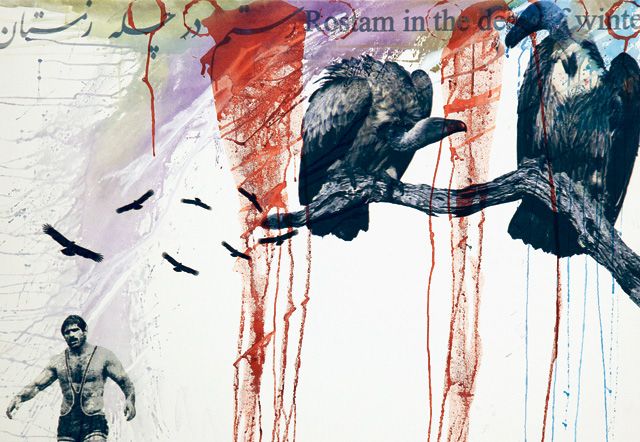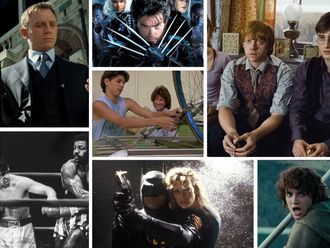Fereydoun Ave was educated in the United Kingdom and the United States. But the well-known Iranian artist remains deeply connected to his roots. His art is imbued with elements of Persian culture and his Zoroastrian heritage. A recurring image in his work is that of Rostam, a pre-Islamic hero drawn from Persian poet Ferdowsi’s epic Shahnameh (Book of Kings). Ave has created several series of works based on this well-known character. The artist also draws inspiration from nature and often uses the seasons as metaphors for his state of mind and his perception of the world. The title of his latest exhibition in Dubai — Rostam in the Dead of Winter — gives an indication of his present concerns. The exhibition includes mixed media paintings on canvas and paper.
In an earlier series, titled Rostam in Late Summer, Ave portrayed his symbolic hero amid flowers in bloom. But in this series Rostam is seen wandering in a stark, snowy white landscape, surrounded by hyenas and vultures.
In dark shades
The sense of impending death and the winter gloom are heightened by the artist’s palette of greys, blacks and browns and drippings of paint on the canvas. The title and imagery might suggest a pessimistic mood, but Ave wants to convey the contrary. “This series is about dying and resurrection. I feel that today the world is in a state of stagnation. And I believe that it is time for all these ‘nearly dead’ to die and be reborn and rejuvenated.
Although there is a macabre facet to this series, there is also a note of optimism because only when winter is over can we hope for the arrival of spring and only after death can there be rebirth and rejuvenation,” he says.
Explaining the concept behind his paintings, Ave says: “Rostam is part of my cultural roots and I connect with him. I see him as a cross between Hercules and Lancelot. In my paintings he represents every man. He is a macho-mystic symbol who personifies chivalry and a certain code of conduct that is now dying. We need to once again find an ethical code of conduct for living together. The hyenas and vultures around Rostam represent the ancient Egyptian scavenger deities of resurrection, Anubis and Mut, who eat the dead and resurrect them through their own bodies. These mythological creatures in my paintings offer hope of creative destruction, renewal and change for the better.”
Ave likes to experiment with media, techniques and technology. In this series he has used acrylic paints, watercolours, pencils, pastels and digital images. He has carefully developed his concept layer by layer. The background layer is replete with spontaneous splashes and drippings of paint on a predominantly white vista. In the next layer digital images of Rostam, the hyenas and the vultures are printed on to the canvas or paper. And finally Ave adds the finishing touches with his brush.
Universal appeal
Although his imagery is derived from Persian culture, Ave denies that his paintings are only about his country’s political, social and cultural realities. “Art is universal. Today the world is so interconnected that we must think out of the ethnic box. I use Persian symbols because I refer to the world through my roots. But I am a 21st-century person.
“What I say through my paintings reflects my feelings about the whole world. Artists are not politicians and art is not about conveying a message. It is about expressing your feelings. Artists are like antennae. They pick up the vibrations all around them and express their emotions through their work,” Ave says. The artist also denies that the presence of Rostam is an expression of his longing for the old way of life. “This series is not about nostalgia, because rejuvenation cannot be about the old. I long for renewal,” he says.











